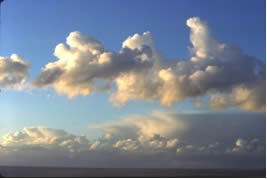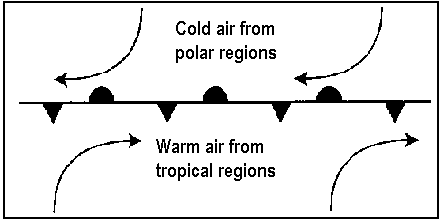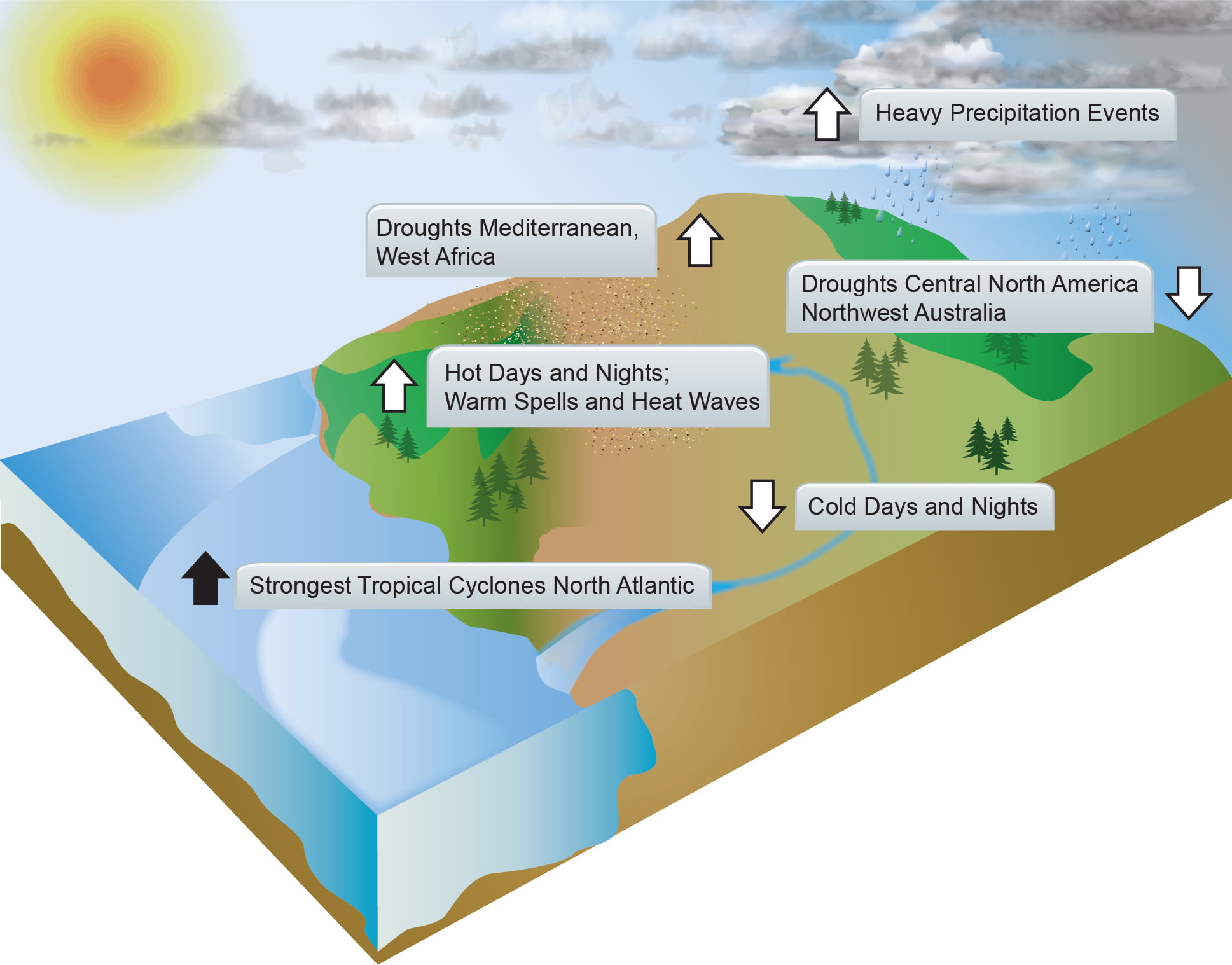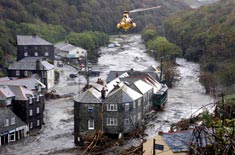 Local winds occur on a small spatial scale, their horizontal dimensions typically several tens to a few hundreds of kilometres. They also tend to be short-lived lasting typically several hours to a day. There are many such winds around the world, some of them cold, some warm, some wet, some dry. There are many hazards associated with the winds.
Local winds occur on a small spatial scale, their horizontal dimensions typically several tens to a few hundreds of kilometres. They also tend to be short-lived lasting typically several hours to a day. There are many such winds around the world, some of them cold, some warm, some wet, some dry. There are many hazards associated with the winds.
The main types of local winds are sea breezes and land breezes, Anabatic and katabatic winds, and Foehn winds.
You can discover different ways to measure wind speed on our Experiments and Demonstrations page, or on our Top 10 Ideas for Weather Fieldwork page.
Anabatic winds
 This wind is caused by thermal (heat) processes. Anabatic (upslope) winds occur over slopes which are heated by the sun. Air which is in contact with slopes that are warmed expands upward and cool and sinks over neighbouring valleys (see diagram). Anabatic winds are usually slow, at only 1-2m/s and are rarely important expect near coasts where they can increase the strength of sea breezes.
This wind is caused by thermal (heat) processes. Anabatic (upslope) winds occur over slopes which are heated by the sun. Air which is in contact with slopes that are warmed expands upward and cool and sinks over neighbouring valleys (see diagram). Anabatic winds are usually slow, at only 1-2m/s and are rarely important expect near coasts where they can increase the strength of sea breezes.
Katabatic Winds
 Katabatic (downslope) winds occur over slopes which are cooled. Katabatic winds occur where air in contact with sloping ground is colder than air at the same level away from the hillside over the valley (see diagram). Katabatic winds are nocturnal phenomena in most parts of the world (i.e. they tend to happen at night) as there is surface cooling, especially when there is little cloud and due to lack of heating by the sun.
Katabatic (downslope) winds occur over slopes which are cooled. Katabatic winds occur where air in contact with sloping ground is colder than air at the same level away from the hillside over the valley (see diagram). Katabatic winds are nocturnal phenomena in most parts of the world (i.e. they tend to happen at night) as there is surface cooling, especially when there is little cloud and due to lack of heating by the sun.
Katabatic wind speeds do not typically not exceed 3 or 4 m/s. However, where the ground is covered with snow or ice, katabatic winds can occur at any time of day or night with speeds often reaching 10 m/s, or even more if funnelling through narrow valleys occurs. Katabatic winds may lead to the formation of frost, mist and fog in valleys.
Sea Breeze
Sea breezes are the result of differential heating of the land and the sea. Sea breezes occur by day, when the land becomes warmer than the sea.
Warm air from the land cannot expand into the sea as the air is cooler and more dense, so it expands up into the atmosphere. Cumulus clouds tend to form as the warm air rises over the land to about 500-1500m.
The diagram below shows the whole sea breeze process.
Air in sea breezes is cool and moist compared to the air over the land. Sea breezes can move 70km inland in temperate climates by 9pm in the evening. Sea breezes can be noticed several kilometres out to sea. In the tropics they can be felt 20km from the land. Wind speeds from sea breezes can be about 4-8m/s but can be even stronger.

Land Breezes
Land breezes occur at night and in the early morning, when the land is cooler than the sea. This is because as the air cools in the night time (as there is less heating from the sun) it contracts. Pressure is higher over the land than the sea. This causes the air to flow from the land to the sea which is known as a land breeze. The circulation is completed by air rising and moving towards the land at 100-300m.
This is shown on the diagram below.

Cumulus clouds from where there is rising air. Land sea breeze fronts tend to only affect a small area of 10-15km out to sea, in comparison to the much larger effect of sea breezes. Wind speeds are also lower at 2-3m/s.
As well as local winds and local weather phenomena, the following list includes seasonal winds with local names:
The Bise
A cold dry wind which blows from the north-east, north or north-west in the mountainous regions of southeastern France and western Switzerland in winter months. The bise is accompanied by heavy cloud.
The Bora
 The bora is a strong, cold and gusty north-easterly wind which descends to the Adriatic Sea from the Dinaric Alps, the mountains behind the Dalmatian coast (the coast of Croatia). It is a winter phenomenon that develops when a slow-moving depression is centred over the Plain of Hungary and western Balkans so that winds are blowing from the east towards the Dinaric Alps. These mountains form a barrier which trap the cold air to the east of them whilst the Adriatic coast remains comparatively mild. Gradually, though, the depth of the cold air increases until the air flows over passes and through valleys to reach the Adriatic Sea.
The bora is a strong, cold and gusty north-easterly wind which descends to the Adriatic Sea from the Dinaric Alps, the mountains behind the Dalmatian coast (the coast of Croatia). It is a winter phenomenon that develops when a slow-moving depression is centred over the Plain of Hungary and western Balkans so that winds are blowing from the east towards the Dinaric Alps. These mountains form a barrier which trap the cold air to the east of them whilst the Adriatic coast remains comparatively mild. Gradually, though, the depth of the cold air increases until the air flows over passes and through valleys to reach the Adriatic Sea.
The bora begins suddenly and without warning and the cold air typically descends to the coast so rapidly that it has little time to warm up.
The bora can reach speeds of more than 100 km/h and has been known to overturn vehicles and blow people off their feet.
The Chinook Wind
A warm, westerly wind found in western North America – Canada and the USA, when air from the Pacific blows over the Rocky Mountains and other upland areas. On January 15th, 1972, the Chinook caused the temperature in Lorna, Montana to rise from -48°C to 9°C in 24 hours! The fastest wind speed recorded during a Chinook was 107mph, in Alberta, Canada.
The Crachin
The name given to the drizzly weather with low stratus, mist or fog which occurs from time to time during the period January to April over the China Sea and in coastal areas between Shanghai and Cape Cambodia. It occurs when cool, moist air from the north encounters warm, moist air, and it is intensified by orographic lifting and/or by coastal convergence.
The Etesians/ Meltemi
The strong northerly winds which blow at times over the Aegean Sea and eastern parts of the Mediterranean Sea during the period May to October. The winds are known as meltemi in Turkey.
The Föhn (or Foehn)
 The Föhn is a warm, dry, gusty wind which occurs over the lower slopes on the lee side (the side which is not directly exposed to wind and weather) of a mountain barrier. It is a result of forcing stable air over a mountain barrier. The onset of a Föhn is generally sudden. For example, the temperature may rise more than 10°C in five minutes and the wind strength increase from almost calm to gale force just as quickly. Föhn winds occur quite often in the Alps (where the name Föhn originated) and in the Rockies (where the name chinook is used). They also occur in the Moray Firth and over eastern parts of New Zealand’s South Island. In addition, they occur over eastern Sri Lanka during the south-west monsoon.
The Föhn is a warm, dry, gusty wind which occurs over the lower slopes on the lee side (the side which is not directly exposed to wind and weather) of a mountain barrier. It is a result of forcing stable air over a mountain barrier. The onset of a Föhn is generally sudden. For example, the temperature may rise more than 10°C in five minutes and the wind strength increase from almost calm to gale force just as quickly. Föhn winds occur quite often in the Alps (where the name Föhn originated) and in the Rockies (where the name chinook is used). They also occur in the Moray Firth and over eastern parts of New Zealand’s South Island. In addition, they occur over eastern Sri Lanka during the south-west monsoon.
 The danger of a Föhn where there are steep snow-covered slopes is that avalanches may result from the sudden warming and blustery conditions. In Föhn conditions, relative humidity may fall to less than 30%, causing vegetation and wooden buildings to dry out. This is a long-standing problem in Switzerland, where so many fire disasters have occurred during Föhn conditions that fire-watching is obligatory when a Föhn is blowing.
The danger of a Föhn where there are steep snow-covered slopes is that avalanches may result from the sudden warming and blustery conditions. In Föhn conditions, relative humidity may fall to less than 30%, causing vegetation and wooden buildings to dry out. This is a long-standing problem in Switzerland, where so many fire disasters have occurred during Föhn conditions that fire-watching is obligatory when a Föhn is blowing.
An explanation of the Föhn effect in the UK from BBC weather.
The Gregale (or Grigale)/ Euroclydon/ Euraquilo
A notorious wind of the western Mediterranean which also blows across central parts of the Mediterranean Sea. It is a strong and cold wind from the north-east and occurs mainly in winter. It is most pronounced on the island of Malta, where it sometimes reaches hurricane force and endangers shipping.
The Bible tells us that the ship which carried St Paul and other prisoners across the Mediterranean en route to Rome was driven by a storm from Crete to Malta, where it was eventually wrecked.
The ship set sail from a bay called Fair Havens near Lasea on the south coast of Crete, having put into this bay to wait for favourable conditions after being delayed by contrary winds. As the bay was exposed to storms, it was not considered a safe place to remain at the time of year in question, which was either late September or early October. The harbour at Phoenix on the south-western coast of Crete was considered a safer place to spend the winter. Soon after the ship left Fair Havens, however, a severe gale began to blow. So violent was the storm that the sailors could do no more than drift with the wind. The Bible tells us that the ship reached Malta fourteen days later.
Paul experienced a gregale. As these winds normally last no more than four or five days, the storm he experienced appears to have been unusually persistent.
The Harmattan
A dry and comparatively cool wind which blows from the east or north-east on the coast of North Africa between Cabo Verde and the Gulf of Guinea during the dry season (November to March). It brings dust and sand from the Sahara Desert, often in sufficient quantity to form a thick haze which hinders navigation on rivers. Dust and sand are sometimes carried many hundreds of kilometres out to sea.
The Helm Wind
An easterly wind found in Cumbria, N. England, where the winds blow over Cross Fell and then descend into the Eden Valley. A bank of cloud forms over the hill tops, and the roaring of the wind can be heard as far away as Penrith.
Discovering Britain A walk across Great Dun Fell from the RGS, exploring the Helm wind and lots of other weather, as well as stories of sheep, socks, snow and spies and a relevant article from Weather: The Helm wind of Cross Fell .
The Kaus/Suahili
The name given to the south-easterly winds which prevail in winter (December to April) in the Persian Gulf. They are accompanied by gloomy weather, rain and squalls and are sometimes followed by very strong south-westerly winds called suahili.
The Khamsin
A hot, dry, dust-laden, southerly wind over Egypt, the Red Sea and eastern parts of the Mediterranean Sea ahead of eastward-moving depressions. It occurs during the period February to June, being most frequent in March and April. The Khamsin is a Sirocco wind, whose name comes from the Arabic word for ‘fifty’, which is approximately the length of time the wind blows for. In the nineteenth Century, the plague was worst in Egypt when the Khamsin was blowing.
The Kharif
A strong south-westerly wind which blows daily over the Gulf of Aden from about 22:00 hours until about noon the following day. It occurs in June, July and August (during the south-west monsoon) and frequently reaches gale force.
The Leste
A hot, dry, southerly wind which occurs in winter and spring between Madeira and Gibraltar and along the coast of North Africa ahead of an advancing depression.
The Levanter
A moist wind which blows from the east over the Strait of Gibraltar. It is frequently accompanied by haze or fog and may occur at any time of year, though it is most common in the period June to October. A feature is the occurrence of a ‘banner cloud’ extending a kilometre or more downwind from the summit of the Rock of Gibraltar.
The strength of the Levanter does not normally exceed Beaufort Force 5. When it is strong, however, complex and vigorous atmospheric eddies form in the lee of the Rock, causing difficult conditions for yachtsmen and the pilots of aircraft. The levanter can also cause persistently foggy weather on the coast of Spain.
The Levenche
A hot, dry, southerly wind which blows on the south-east coast of Spain ahead of an advancing depression. It is typically laden with sand and dust, and its approach is often heralded by a belt of brownish cloud on the southern horizon.
The Libeccio
A strong, squally, south-westerly wind which occurs over central parts of the Mediterranean Sea, most common in winter.
The Maestro
The name given to north-westerly winds over the Adriatic Sea, the Ionian Sea and coastal regions of Sardinia and Corsica.
The Marin
A strong south-easterly wind over the Golfe du Lion. It is usually accompanied by warm, cloudy weather with rain.
The Mistral
 The mistral is also a strong and often violent wind. It blows from the north or north-west down the Rhône Valley of southern France and across the Rhône Delta to the Golfe du Lion and sometimes beyond. Though strongest and most frequent in winter, it may blow at any time of year and develops when stable air is forced through the Rhône Valley. It occurs when a depression is centred over north-west Italy and the Ligurian Sea and a ridge of high pressure extends north-eastward across the Bay of Biscay.
The mistral is also a strong and often violent wind. It blows from the north or north-west down the Rhône Valley of southern France and across the Rhône Delta to the Golfe du Lion and sometimes beyond. Though strongest and most frequent in winter, it may blow at any time of year and develops when stable air is forced through the Rhône Valley. It occurs when a depression is centred over north-west Italy and the Ligurian Sea and a ridge of high pressure extends north-eastward across the Bay of Biscay.
It may blow continuously for a day or two and attain speeds of 100 km/h, causing considerable damage to crops and making driving conditions difficult in the Rhône Valley. It clears clouds and pollution out of the air. In the Rhone valley in France, trees lean to the South because of the force of the Mistral.
The Norther
This name for a wind is used in more than one place. In Chile, a Norther is a northerly gale with rain. It usually occurs in winter but occasionally occurs at other times of year. Typically, it can be identified by falling air pressure, a cloudy or overcast sky, good visibility and water levels below normal along the coast.
Over the Gulf of Mexico and western parts of the Caribbean Sea, Northers are strong, cool, northerly winds which blow mainly in winter. Over the Gulf of Mexico, they are sometimes humid and accompanied by precipitation, but over the Gulf of Tehuantepec they are dry winds.
Pampero
The name given to severe line squalls in Argentina and Uruguay, particularly in the Rio de la Plata area. They are associated with marked cold fronts and are usually accompanied by rain, thunder and lightning, a sharp drop in temperature and a sudden change of wind direction from northerly or northwesterly to southerly or south westerly. They are most likely to occur during the period June to September.
Roaring forties
Strong westerly winds found in the Southern Hemisphere between 40 and 50 degrees South. Sailing ships have always made use of them. The winds are much stronger in the Southern Hemisphere because there is very little land to slow them down – only Tasmania, New Zealand and the very bottom of South America.
The Santa Ana
A hot, dry, strong, blustery, föhn-type wind which blows from the north-east or east over southern California and carries with it large quantities of dust. It is most frequent in winter but may also occur in spring or autumn. It may get its name from the Santa Ana Mountains or the Santa Ana Canyon but other possibilities are that it derives from santanas, meaning ‘devil winds’, or the Spanish Satanás, meaning Satan. These winds can cause a great deal of damage. As they are hot and dry, they cause vegetation to dry out, so increasing the risk of wildfires; and once fires start the winds fan the flames and hasten the spread of the fires. In spring, Santa Ana winds can cause considerable damage to fruit trees.
Shamal
Strictly, the shamal is any north-westerly wind over the Persian Gulf and Gulf of Oman, but the term usually refers not to the normal prevailing winds but to the squally gale-force winds accompanied by rain and thunder which occur in winter.
The Scirocco/ Sirocco
A hot, dry wind southerly wind which blows from the Sahara in northern Africa into the southern Mediterranean. It picks up moisture as it crosses the Mediterranean and can reach Spain, France, Italy and Greece bringing Saharan dust and hot, windy, damp weather, often with fog or low stratus cloud. In spring, the Sirocco can bring gale force winds. There are many local names for the Sirocco, including chom, arifi, Simoom, Ghibli, Chili, Khamsin, Solano, Leveche, Marin and Jugo.
The Solano
An easterly or south-easterly wind, with rain, which occurs in the Strait of Gibraltar and over south-eastern coasts of Spain.
Southerly-buster
The name given to the violent squalls which are associated with well-defined active cold fronts over coastal regions of southern and south-eastern Australia. They are accompanied by lightning, thunder and gale-force winds and are similar to pamperos. They are most frequent in summer but may also occur in spring and autumn.
Sumatra
These are characteristically squally local winds which occur over the Malacca Strait several times a month during the period April to November. They are always accompanied by heavy rain from cumulonimbus clouds and are almost always accompanied by lightning and thunder. They are initiated by katabatic winds and therefore tend to occur at night.
Tehuantepecer
A violent squally wind from the north or north-east in the Gulf of Tehuantepec in winter. It originates in the Gulf of Mexico as a norther and blows across the Isthmus of Tehuantepec.
The Trade wind
Easterly winds in the Tropics (between the Tropic of Cancer and the Tropic of Capricorn). The Trade winds helped European explorers reach America.
Tramontana
A cold, dry, northerly or north-westerly wind over the coast of Catolina and a cold, dry northerly or north-easterly wind over the west coast of Italy and the north coast of Corsica. It is typically a strong wind but does not often reach gale force.
The Vendavales
Strong, squally, south-westerly winds off the east coast of Spain and in the Strait of Gibraltar. They occur mainly during the period September to March and are often accompanied by violent squalls, heavy rain and thunderstorms.
Williwaw
A sudden, cold, violent wind found in Alaska and Cape Horn which blows from the mountains to the sea.
Willy-Willy
A willy-willy is a dust storm over north-west Australia. More information.
The Zonda/Sondo
This term applies to two different phenomena. It usually refers to a dry and often dusty föhn wind that occurs over the eastern slopes of the Andes in central Argentina in winter months. It is also the name (or sondo) given to a hot, humid, northerly wind over the Pampas region of South America in advance of an eastward-moving depression and preceding a pampero occurrence.




